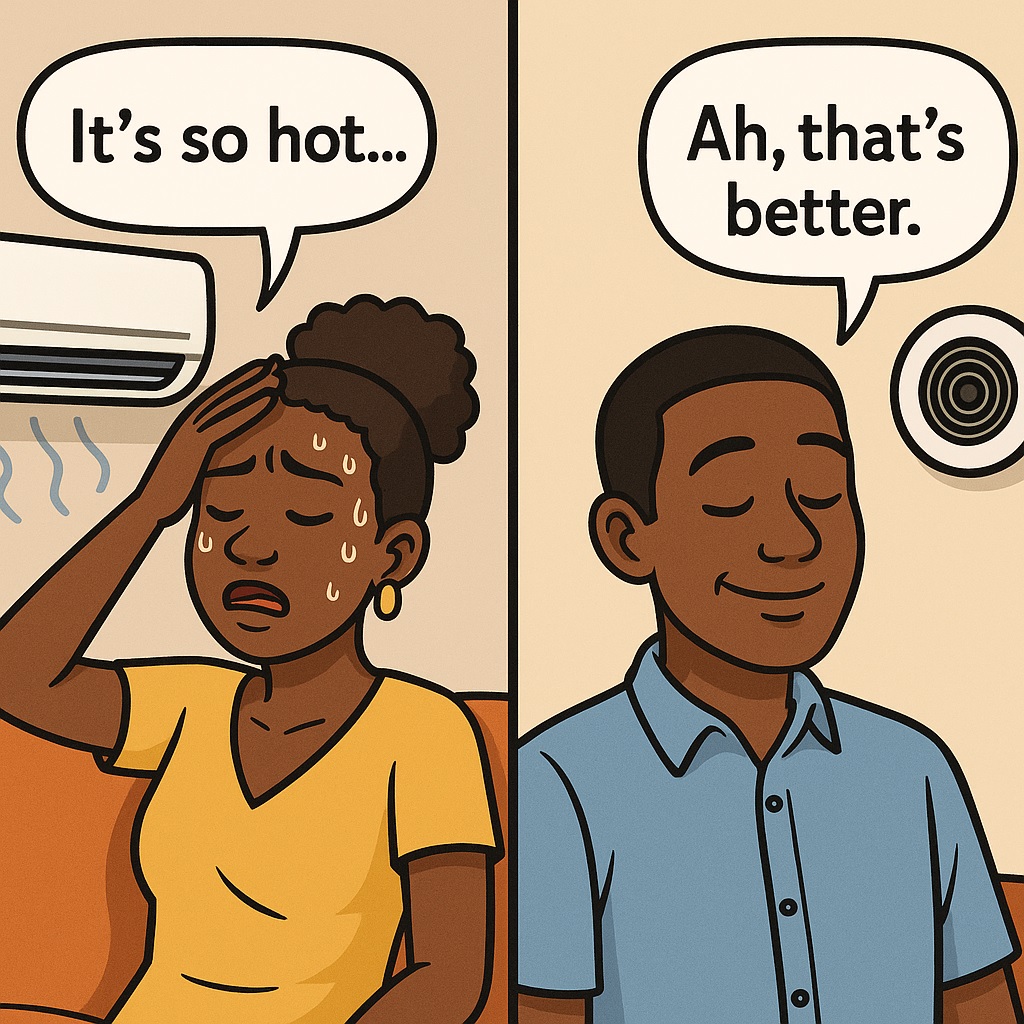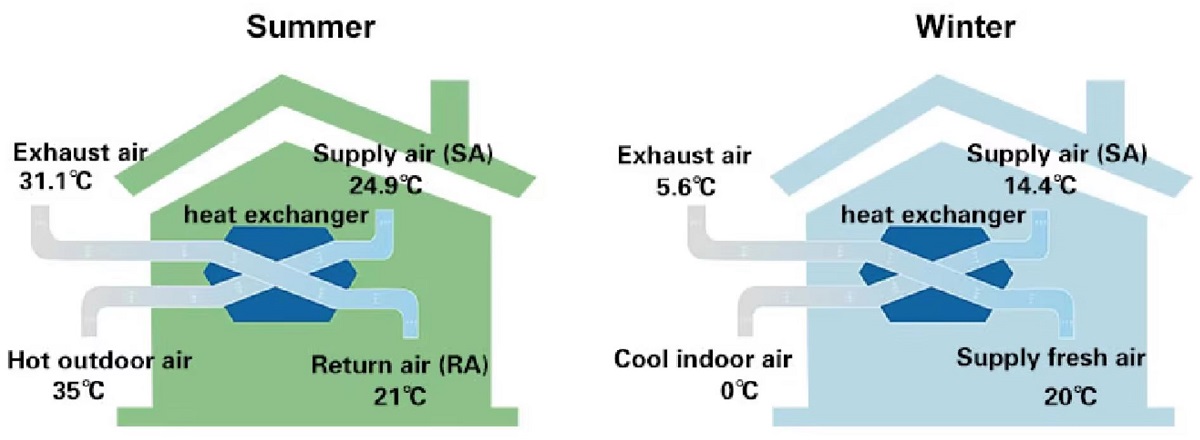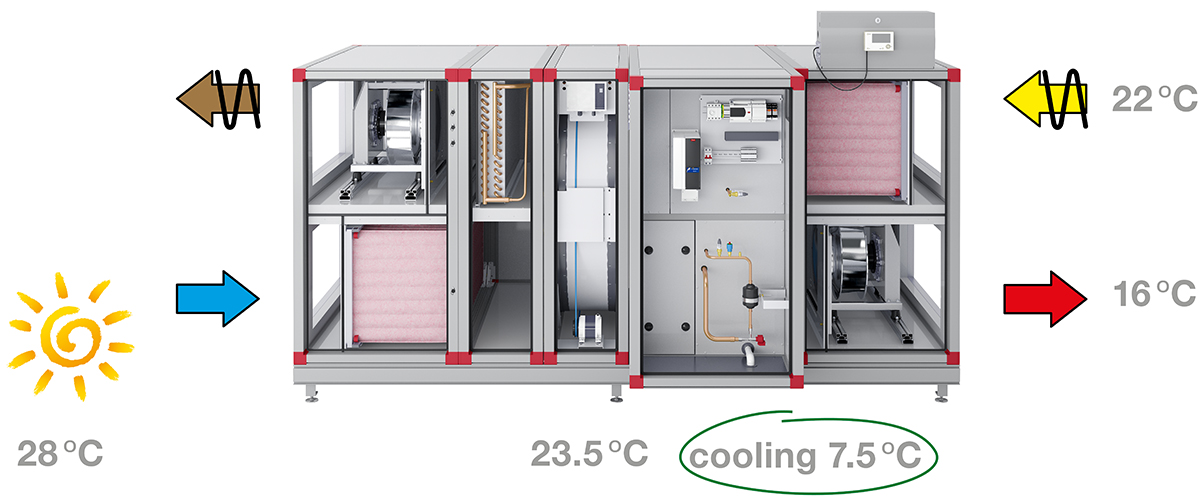Cooling ventilation system for homes and buildings in Botswana

In Botswana’s hot climate, indoor comfort and energy efficiency are more important than ever. This page introduces a Nordic cooling ventilation system designed to reduce AC usage, improve air quality, and create a healthier indoor environment – even during peak heat.
Why we’re testing interest in Botswana
VXPRO is evaluating the possibility of launching energy-saving ventilation systems adapted for homes, schools, offices and hotels in Botswana. This page is part of our market survey. If you’re interested in better cooling with lower energy bills, we’d love to hear from you.
How does the cooling ventilation system actually work?
The system is based on a rotary heat exchanger – a spinning aluminum wheel located inside the ventilation unit. This wheel rotates between two air streams: the warm outdoor air coming in, and the cooler indoor air being expelled.
As the wheel spins, it absorbs thermal energy (heat) from the outgoing air and releases it into the incoming air – or in hot climates like Botswana, it does the opposite. The cooler indoor air transfers its lower temperature into the wheel, and as the wheel continues rotating, it cools down the warmer outdoor air before it enters the building.
This means the air entering your home or office is already cooler than the outside air, without any compressor or refrigerant. It’s called energy recovery – and in this case, it works like a passive pre-cooling step before air conditioning is needed. The result: less energy consumption, reduced load on AC units, and improved comfort.
Key benefits in hot climates:
- Pre-cools outdoor air using energy from your own building
- Lowers indoor temperature before AC starts
- No refrigerants or active cooling required
- Constant airflow with filtered, fresh air
Why not just use portable AC, fans or evaporative coolers?
Portable air conditioners, fans, and swamp coolers (evaporative units) are popular in Botswana – and they do provide quick relief. But they also come with high electricity use, poor air filtration, and often only treat the symptoms, not the cause.
Our cooling ventilation system is a different approach. It brings in outdoor air – filtered and pre-cooled – and replaces stale indoor air continuously. That means you get fresh air, lower temperatures, and lower electricity bills, especially when used together with AC.
| Solution | Electricity use | Air quality | Cooling effect | Fresh air exchange | Maintenance |
|---|---|---|---|---|---|
| Cooling ventilation system | Very low | High (filtered) | Moderate (pre-cooling) | Yes – continuous | Filter change 1–2×/year |
| Portable air conditioner | High | Low (recirculated) | Strong, local | No – recirculates air | Cleaning, drainage, electricity |
| Evaporative cooler (swamp cooler) | Medium | Low (humidifies air) | Variable – limited in humidity | No | Water refills, cleaning |
| Fan / tower fan / neck fan | Low | Very low | Only airflow – no real cooling | No | Minimal |
Why this ventilation system is ideal for Botswana
Botswana’s climate is hot and dry for most of the year. Daytime temperatures often exceed 35 °C, and indoor spaces easily overheat due to solar exposure and limited airflow. While air conditioners are common, they consume large amounts of electricity – which can be costly and difficult to scale across entire buildings.
This is where a cooling ventilation system makes sense. Instead of relying entirely on active cooling, this system helps reduce indoor temperatures by pre-cooling the incoming air and continuously replacing stale indoor air with filtered, fresher air. The system uses only low-power fans and a rotating energy recovery exchanger – making it far more energy-efficient than standard AC.
It can also be combined with solar power or backup batteries for even greater independence and reliability in areas where energy access is limited.
Because the air is filtered, it also helps protect your indoor environment from dust, insects, smoke, and outdoor pollution – improving health and comfort, especially in urban and roadside environments.
Who should use a cooling ventilation system?
This type of ventilation system is ideal for anyone looking to improve indoor air quality and thermal comfort while keeping energy use low. It can be used in both new buildings and retrofits, and it works especially well in climates like Botswana’s, where daytime temperatures are high and fresh air is needed year-round.
Best suited for:
- Private homes and apartments
Reduce overheating during the day, improve sleep comfort at night, and breathe cleaner air with filtered, cooled ventilation. - Schools and classrooms
Children concentrate better in well-ventilated, comfortable rooms. This system improves air hygiene and reduces the need for noisy fans or split AC units. - Offices and commercial spaces
Create a better working environment with continuous airflow and reduced heat buildup – while keeping energy bills under control. - Hotels and lodges
Offer guests cleaner, cooler air with low noise and minimal power use. Ideal for eco-conscious resorts or remote locations with limited energy capacity.
How does the system work – step by step
This cooling ventilation system delivers filtered outdoor air and removes excess heat using a built-in energy recovery unit. Here's how it works:
- Outdoor air intake
Fresh air is drawn from outside through an intake vent, usually placed on a shaded wall or roof area. - Built-in air filters in the ventilation unit
As the air enters the ventilation unit, it passes through integrated filters that remove dust, smoke particles, pollen and insects. This improves air quality, especially in dusty or polluted environments. - Rotary energy recovery wheel
A rotating aluminum wheel transfers thermal energy between the two air streams. In hot climates, the outdoor air is typically warmer than the indoor air. As the wheel rotates, it absorbs heat from the incoming outdoor air and releases it into the cooler exhaust air – thereby reducing the temperature of the supply air before it enters the building.

- Low-power supply and extract fans
Two quiet fans move air in and out of the building continuously, maintaining a balanced flow with minimal electricity use. - Room-by-room air distribution
The cooled, filtered air is supplied to living spaces through ceiling or wall vents, while stale air is extracted from kitchens, bathrooms and other areas with high humidity or heat.

What about condensation – does it occur?
Yes, condensation can occur in cooling ventilation systems, but only under specific conditions. When hot and humid outdoor air is cooled down inside the energy recovery unit, the moisture in the air may reach its dew point. This means that water droplets form inside the unit – typically on the exhaust side of the heat exchanger.
This is a normal part of how passive cooling works. To handle this, the ventilation unit is equipped with a drainage system that collects and safely removes any condensate. In some systems, additional design elements like anti-drip coatings or tilted internal surfaces help ensure that moisture is never carried back into the supply air.
In Botswana’s climate, condensation may happen during the rainy season or in high-humidity areas – but for most of the year, outdoor air is dry enough that no condensation occurs. Either way, the system is built to manage it automatically.
How much does it reduce AC usage?
While this system doesn’t replace air conditioning entirely, it can significantly reduce how much your AC needs to run. By pre-cooling the incoming outdoor air using energy recovery, the system lowers the temperature of the supply air by 4 to 10 °C – depending on outdoor and indoor conditions.
This means your AC unit doesn’t have to cool from 36 °C down to 24 °C, but rather from 28–32 °C to 24 °C. That difference can cut AC runtime by 30–50%, especially during moderate heat or overnight hours when outdoor air is still too warm to bring in directly without treatment.
The system also includes a night cooling function, where cool outdoor air is flushed through the building structure during night hours. This helps reduce the internal temperature of walls, floors and ceilings – storing “coolth” in the building mass. As a result, the entire building starts the next day several degrees cooler, delaying or even avoiding the need for air conditioning in the morning.
Together, these features help reduce energy consumption, improve comfort, and extend the life of AC systems – while maintaining fresh, filtered indoor air around the clock.
Interested in cooling ventilation for your building?
We’re currently evaluating the demand for a Nordic-style ventilation system with energy recovery and cooling effect, adapted for Botswana’s climate. If this sounds interesting to you, please send us a short message. We’ll follow up with more information.





 E‑mail us
E‑mail us